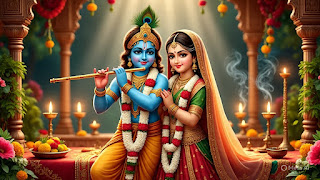Unlocking the Secrets of Spiritual Aesthetics Through the Lens of Rupa Goswami
We often treat aesthetics as external — fashion, design, architecture. But what if beauty is the most direct path to the Divine? What if the soul recognizes God not through logic… but through delight?
Rupa Goswami, the architect of Bhakti-Rasa, was not
just a saint — he was a spiritual aesthetician. He didn’t seek God in
silence alone; he sought Him in the shimmer of a flute, the curve of a
smile, the scent of sandalwood, the colour of dusk on Vrindavan’s sky.
To Rupa, beauty was not a distraction from
devotion — it was devotion. He awakened a radical idea: that the
experience of divine beauty stirs something ancient and eternal in the soul.
When the heart is moved by the aesthetic of the Divine, it becomes
receptive — and in that surrender, the Beloved enters.
🎨
Aesthetic Experience Is a Soul Experience
For most of us, beauty is surface-deep. But in the
Bhakti tradition shaped by Rupa Goswami, beauty becomes sacred architecture.
The sound of Krishna’s flute is not just melodious — it’s liberating.
Radha’s expressions are not decorative — they are gateways into spiritual
rasa.
This approach doesn’t ask you to renounce beauty. It
asks you to re-sacralize it.
Modern spiritual seekers often feel the tension
between stillness and stimulation. But Rupa teaches: The problem is not
beauty — it’s identification. When beauty is turned toward ego, it becomes
vanity. When turned toward God, it becomes ecstasy.
🌺
Spiritual Aesthetics Is the Bridge Between Bhava (Feeling) and Darshan (Seeing)
What we see externally is meant to evoke something
internally. That’s the secret of Seva through Shringar — devotional
service through decorating the Divine. The flowers, the colors, the silks —
they don’t “please” God in the human sense. They awaken us. They remind
us we’re not interacting with a symbol — we’re interacting with a Beloved.
Rupa Goswami’s writings were filled with aesthetic
imagery — because he knew: A soul doesn’t fall in love with a philosophy. It
falls in love with presence, mood, beauty.
🧰
Practical Toolkit: Spiritual Aesthetic Rituals for Daily Life
1. Bhakti Mood Board:
Create a physical or digital collage with images, colors, and textures that
evoke devotion in you — Vrindavan landscapes, temple arches, Radha-Krishna art,
golden lamps. Look at it before meditation.
2. Sacred Fragrance Practice:
Use natural scents like rose, sandalwood, or jasmine before your spiritual
routine. Let your sense of smell become a signal to your soul: “Enter
the sacred now.”
3. Devotional Dressing:
Once a week, dress not to impress the world — but to offer beauty to the
Divine. Whisper internally: “This is for You.” It turns vanity into
veneration.
4. Soundscape Bhakti:
Play an instrumental flute, veena, or sitar raga softly in the background while
journaling or meditating. Let the sound transport your senses into the
rasa-realm.
5. Darshan Offering Table:
Create a space with flowers, fabric, candles, and a deity or symbol of the Divine.
Change elements daily or weekly. Engage in visual seva — not as decor, but as dialogue.
🌈
Final Note: Beauty as the Fingerprint of God
Rupa Goswami whispered truths many saints only
hinted at — that beauty is not the opposite of God. It’s the evidence of
Him. When you allow yourself to be moved by divine form, your ego
melts. And that melting is Bhakti.
So next time you see something beautiful, pause. Ask
your heart — Is this decoration… or a divine invitation?
Because when spiritual aesthetics become your
language, love no longer needs words.



Comments
Post a Comment